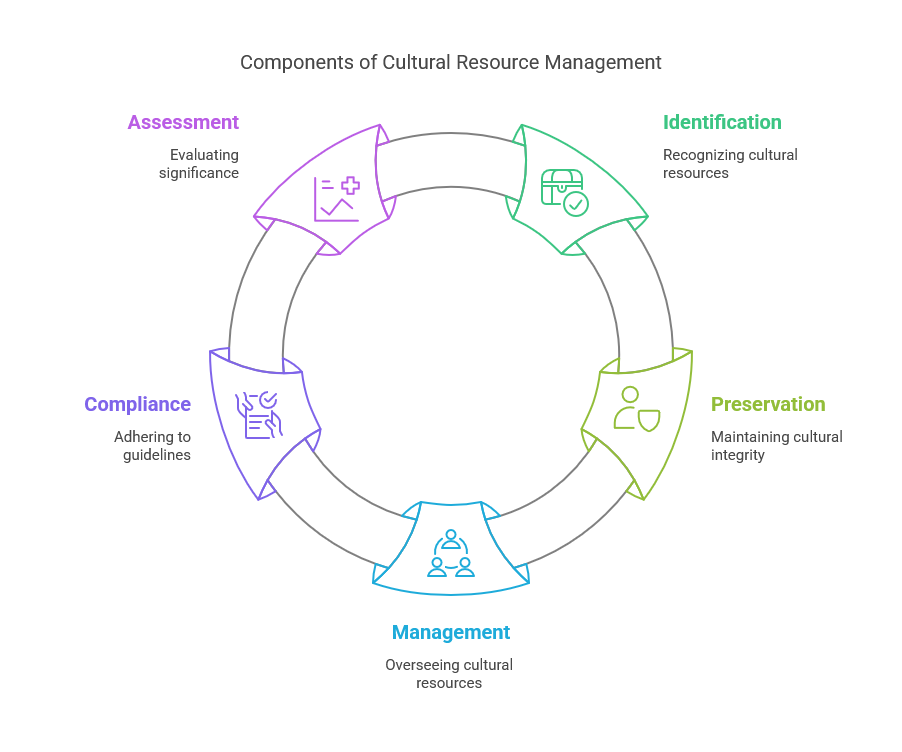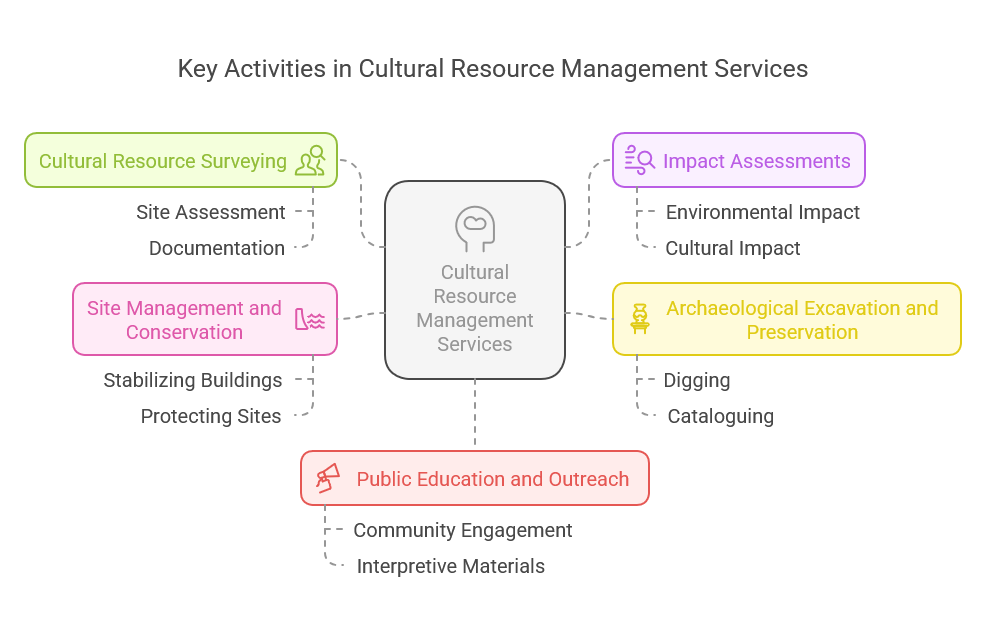Cultural resource management services are vital for preserving and protecting our cultural heritage. As societies evolve and development projects grow, historical, cultural, and archaeological sites must be safeguarded for future generations. Cultural resource management (CRM) plays a significant role in identifying, preserving, and managing these essential resources. Whether protecting ancient monuments, historical landmarks, or indigenous cultural practices, CRM services ensure that cultural heritage is maintained in a rapidly changing world. This article will explore the importance of CRM services, the key activities involved, and how they contribute to preserving history and culture.
What Are Cultural Resource Management Services?
Cultural resource management services involve identifying, preserving, and managing cultural, historical, and archaeological resources. Professionals such as archaeologists, historians, architects, and cultural heritage specialists provide these services, working together to protect valuable assets.
CRM aims to prevent the destruction or loss of cultural resources due to human activities like construction, development, or environmental degradation. These services cover everything from identifying cultural resources to planning and carrying out preservation efforts, all while ensuring compliance with legal, ethical, and environmental guidelines.
These services apply to various historical sites, including ancient archaeological sites, buildings of cultural or architectural importance, and indigenous practices or traditions. Regardless of the resource type, CRM services assess its significance and determine the best methods for its preservation.

Why Are Cultural Resource Management Services Important?
The importance of cultural resource management services can’t be emphasized enough. The following points highlight why CRM is essential for preserving our collective history and culture:
1. Preservation of Cultural Identity
Cultural heritage reflects a community’s identity and history. By preserving cultural resources, CRM services ensure that future generations can connect with their cultural roots. Whether preserving ancient ruins, traditional ceremonies, or historical buildings, CRM helps maintain the link between communities and their past. This connection fosters a sense of belonging and pride within communities and allows people to learn from the successes and failures of those who came before them.
2. Legal and Regulatory Compliance
Many countries have enacted laws and regulations to protect cultural resources. For instance, in the United States, the National Historic Preservation Act (NHPA) mandates that federal agencies assess the impact of their projects on cultural resources. Similarly, international conventions such as UNESCO’s World Heritage Convention outline guidelines for preserving cultural heritage. Cultural resource management services help organizations comply with these legal requirements, ensuring that cultural sites are protected during development or construction projects. Failure to comply with these laws can result in legal penalties or the destruction of irreplaceable resources.
3. Educational Value
Cultural resources provide educational opportunities for learning about the past. From ancient civilizations to recent historical events, cultural heritage can teach valuable lessons about human society, culture, and progress. Museums, schools, and historical societies rely on CRM services to safeguard artefacts and historical sites used for educational purposes. Preserving these resources ensures that future generations can access this knowledge and better understand the history that shaped our world today.
4. Economic Benefits
Cultural heritage can also contribute to economic growth. Many historical sites and cultural landmarks attract tourists, contributing to local economies. Effective CRM services help manage these resources in ways that preserve their integrity while also encouraging responsible tourism. Preserving and maintaining these sites can create jobs, support local businesses, and boost tourism, providing financial benefits to communities.
5. Environmental Protection
Cultural resources are often located in areas that are also environmentally significant. Many archaeological sites, historical landmarks, and indigenous cultural regions are in pristine natural environments. By protecting these cultural resources, CRM services also help conserve the environment. For instance, preserving a historic site on public lands can ensure that construction or development does not disrupt the surrounding ecosystem.
Key Activities in Cultural Resource Management Services
Cultural resource management services encompass various activities to preserve and protect cultural heritage. Below are some of the most common tasks involved:
1. Cultural Resource Surveying
Cultural resource surveying is the process of identifying and documenting cultural and historical resources. It may involve visiting sites to assess their significance, locating potential archaeological sites, or identifying historical buildings. Surveys often result in creating a comprehensive report detailing the findings, which informs decisions about preservation, conservation, or development.
2. Impact Assessments
Impact assessments determine how construction or development projects affect cultural resources. CRM professionals conduct environmental and cultural impact assessments to evaluate the potential threats proposed projects pose. If a project jeopardises a historical site or archaeological resource, mitigation measures can be developed to reduce harm, such as rerouting construction or redesigning the project.
3. Archaeological Excavation and Preservation
Archaeological excavations are vital in uncovering and preserving historical artefacts and remains. CRM archaeologists conduct digs to recover valuable information about past societies. Excavations are performed carefully to prevent damage to the artefacts, and the findings are catalogued and preserved for future study and exhibition. Excavated artefacts may include pottery, tools, bones, or entire structures.
4. Site Management and Conservation
Site management involves the ongoing care and maintenance of cultural resources. This could include stabilizing a deteriorating building, protecting an archaeological site from looting, or controlling visitor access to prevent further damage. CRM services also develop long-term conservation plans to ensure that cultural resources are managed sustainably. These plans outline the measures necessary to protect, preserve, and maintain the site over time.
5. Public Education and Outreach
Public education is a critical component of cultural resource management. Educating the public about the significance of cultural resources helps garner support for preservation efforts. CRM professionals often create interpretive materials, conduct tours, or organize events to raise awareness about the importance of preserving cultural heritage. Outreach programs also involve working with local communities to incorporate their perspectives into preservation planning.

Types of Cultural Resource Management Services
Cultural resource management services are diverse, addressing various needs for protecting and preserving cultural heritage. Below are some of the key services offered:
1. Archaeological and Historical Site Preservation
CRM services can involve preserving archaeological sites, historical landmarks, and buildings of cultural significance. This includes identifying potential threats, developing preservation strategies, and performing restoration work to prevent further deterioration.
2. Cultural Resource Legislation and Compliance
CRM professionals assist clients in navigating complex cultural resource laws and ensuring compliance with national, regional, and international legislation. This includes obtaining permits, submitting reports, and protecting cultural resources during construction or development projects.
3. Artifact Conservation
Artefacts, from ancient tools to religious objects, must be appropriately conserved to prevent damage over time. CRM specialists use specialized techniques to restore and protect artefacts, ensuring they remain in good condition for future study and exhibition.
4. Environmental and Heritage Impact Assessments
CRM services also include conducting heritage and environmental impact assessments to evaluate how planned projects may affect cultural resources. These assessments help avoid the loss of significant cultural and ecological assets and guide decision-making regarding project modifications or cancellations.
Frequently Asked Questions (FAQs)
1. What is cultural resource management?
Cultural resource management involves identifying, preserving, and protecting cultural, historical, and archaeological resources to ensure they are not damaged or lost due to human activities or environmental factors.
2. Why is cultural resource management critical?
Cultural resource management is essential because it helps preserve our cultural heritage, ensuring that future generations can learn from and connect with their history and traditions.
3. Who provides cultural resource management services?
Cultural resource management services are provided by experts such as archaeologists, historians, architects, and cultural heritage specialists who have the necessary training and experience to protect cultural resources.
4. What are the standard services offered under CRM?
Standard services provided under CRM include archaeological surveys, site management, artefact conservation, environmental and heritage impact assessments, and public outreach programs.
5. How do CRM services help with development projects?
CRM services assess how proposed development projects may impact cultural resources. If a project threatens a cultural asset, CRM services help find ways to mitigate the impact, ensuring that development can proceed without damaging valuable heritage.
Cultural resource management services are essential for protecting and preserving our cultural heritage. These services ensure compliance with laws and regulations and contribute to educating the public, supporting local economies, and maintaining cultural identities. As development and construction continue to reshape the landscape, CRM professionals play a crucial role in safeguarding our history for future generations. Without CRM services, many of the world’s most important cultural resources could disappear forever.

